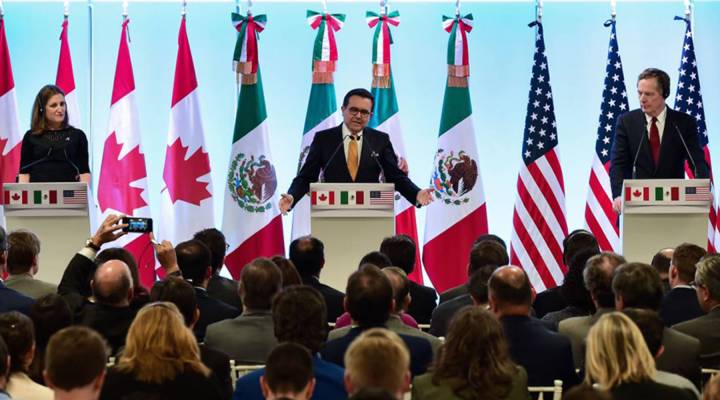
With the potential for a trade war with China dominating headlines over the last few weeks, the news of another major trade negotiation can get lost in the news — NAFTA. Even before taking office, President Donald Trump made his intentions to renegotiate NAFTA very clear.
But after seven rounds of negotiations, what progress has been made? Let’s dive into the nitty gritty and see what exactly has transpired.
But first, a quick history lesson
How about we take a refresher course on what exactly NAFTA is?
NAFTA, the North American Free Trade Agreement, is a signed agreement between the United States, Canada and Mexico, implemented to promote economic growth and prosperity away from the usual trade barriers that exist.
The Clinton administration is often credited with the institution of NAFTA, however, the agreement goes back a little farther than the ’90s. In 1979, while announcing his presidential candidacy, Ronald Reagan proposed a North American accord, which he believed could bolster the trade of all three countries. Later, in 1992, President George H.W. Bush, as well as the leaders of Canada and Mexico, signed the agreement. It was ratified the following year, culminating with President Bill Clinton signing NAFTA into law in 1993.
Today, trade among the United States, Canada and Mexico exceeds $1 trillion, facilitating a trade zone where agriculture, cars and other goods are imported and exported across the continent.
But why are we renegotiating anyway?
We have large trade deficits with Mexico and Canada. NAFTA, which is under renegotiation right now, has been a bad deal for U.S.A. Massive relocation of companies & jobs. Tariffs on Steel and Aluminum will only come off if new & fair NAFTA agreement is signed. Also, Canada must..
— Donald J. Trump (@realDonaldTrump) March 5, 2018
…treat our farmers much better. Highly restrictive. Mexico must do much more on stopping drugs from pouring into the U.S. They have not done what needs to be done. Millions of people addicted and dying.
— Donald J. Trump (@realDonaldTrump) March 5, 2018
Trump has long been a vocal opponent of NAFTA and the role the United States plays in the deal. Part of his problem with it? He said NAFTA led to a loss of manufacturing jobs in the United States, so he ran on a platform that promised to bring those jobs back.
But was NAFTA really a job killer? According to Harvard economist Marc Melitz, manufacturing jobs were already in danger. The rise of automation and “a wave of imports from China” harmed American manufacturers, and in turn, the factory jobs of the American people.
But how did we get here? In April 2017, Trump told the American people he would either renegotiate or exit NAFTA, which, side note, would radically change the face of trade in North America. What really prompted NAFTA renegotiations was Trump’s threat to pull the United States out of the agreement, so on May 18, 2017, renegotiations between the three nations began. Although the original goals have been updated, the overall objectives of the renegotiation have remained the same: to ensure a new NAFTA will “obtain more open, equitable, secure, and reciprocal market access, and the entire NAFTA region will benefit.”
Where is NAFTA right now?
Trade representatives from all three countries are negotiating specific chapters in the 30-chapter deal. Only about five or six are finalized, including chapters on competitiveness, customs and border facilitation, and small- and medium-sized enterprises, according to Laura Dawson, the director of the Canada Institute at the Wilson Center.
But despite this progress, the “major” chapters have yet to be decided. These include dispute settlements, rules of origin on vehicles, the sunset clause and major market access rules, Dawson told Marketplace. As a reminder, the sunset clause is the proposal that would allow NAFTA to expire every five years unless the United States, Mexico and Canada all agreed to reinstate it.
Where is NAFTA headed?
That’s a hard question to answer. On Monday, Mexico’s economy minister Ildefonso Guajardo announced a new deal might come as soon as May. But this week, leaders of North and South America will meet at the Summit of Americas, which could facilitate conversations and maybe even bring new announcements on the status of NAFTA negotiations.
Remember those steel and aluminum tariffs? They could play a role in NAFTA talks. U.S. Trade Representative Robert Lighthizer called the tariffs an incentive “to get a deal.”
Anything else to keep in mind?
Midterm elections in the United States and the Mexican presidential election are both looming on the horizon. According to Duke law professor Rachel Brewster, these elections could change the timeline for Canada and Mexico to sign a deal.
“Mexico might look at the midterms and want to hold off,” she told Marketplace. “If there’s going to be a major change in terms of the politics of the United States, that Trump won’t have the same support that he does now … then they might actually have an incentive to wait it out.”
Marketplace senior reporter Kimberly Adams contributed to this report.
There’s a lot happening in the world. Through it all, Marketplace is here for you.
You rely on Marketplace to break down the world’s events and tell you how it affects you in a fact-based, approachable way. We rely on your financial support to keep making that possible.
Your donation today powers the independent journalism that you rely on. For just $5/month, you can help sustain Marketplace so we can keep reporting on the things that matter to you.












